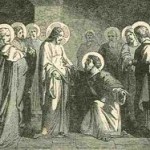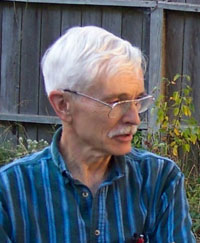What Can I Believe?
A sermon preached by Christopher L. Webber at St. Paul’s Church Bantam, Connecticut, on April 7, 2013.
The problem Thomas had is the basic problem every human being has every day: what can I believe? I have that problem sometimes in a casual conversation with a friend; I have it often when I watch the news or read the paper; I have it sometimes when I think about God; maybe you do, sometimes at least.
What can I believe? Suppose your friend says, There’s a sale at the Bantam Market: steak at 5 cents a pound. Your friend has no intention of misleading you but – you have to ask – did they see it themselves, did they misremember the price, is there some qualification: first five customers, up until noon yesterday, available if you buy five six packs of beer first? We just instinctively, and out of long experience, weigh what we hear by a number of factors: past experience, importance to us, probabilities of various sorts – and then we believe or not, depending.
So: what can I believe and how firmly can I believe it? I think these are fundamental questions we deal with daily. But Thomas was being asked to believe something on which life depends and on three grounds: first what he heard from others, secondly what he could see for himself and thirdly what he could actually touch. Three senses: hearing, seeing, feeling.
The first sense, hearing, he was sure was not enough. I don’t think it ever is when something’s important. Hearsay evidence doesn’t carry much weight and it shouldn’t. If you ever played a game of telephone as a child – you know: you whisper something to one who whispers it to the next and who knows what will come out at the other end of the chain?
I remember a news report, probably five or six years ago, when Barack Obama was running for the first time and reports were being spread that he was a Muslim. A reporter was asking some men in a midwestern diner who they would vote for and why and someone said he couldn’t vote for Obama because he was a Muslim. And the reporter said, “Well, but he isn’t a Muslim.” And the man in the diner said, “But what’s what I’ve heard.”
So hearing isn’t very reliable and Thomas knew that and wasn’t about to rely on it, nor was he even ready to be satisfied by seeing. “Seeing’s believing” is the old saying but any magician knows that the hand is quicker than the eye and we can think we see something that’s not really there. In an age when virtual reality is a familiar idea, when we can project holographic images, when we can go to the movies and be shown special effects that are totally unreal, seeing is not believing.
The result is that touch and feel become more important than ever and especially because of what we are as human beings. I am a flesh and blood, material human being. I may see things, hear things, imagine things, but it’s touch that brings me into relationship with what I am: flesh and blood, material, capable of banging into things, being hurt by the collision; that’s reality as we experience it. That’s what we can believe.
Now, I thought I might use this story about Thomas to talk about how important the sacraments are to us. Our worship is not just sight and sound as some worship is. We don’t come here just to listen and speak as some worshipers do but to taste and touch. To make new members of the church we don’t just announce it, we pour water over them. We don’t just pronounce two people husband and wife, we join their hands and wrap a stole around them. Today we use bread and wine to know Christ’s presence here. Jesus says to us as he said to Thomas, “Reach out your hand and feel this bread, my body, and know that I am with you still.” 
Christianity is about God’s relationship with the material world. At the center of our faith is the fact that God came into this material world God created and lived in it in real flesh and blood. It’s an incarnational faith and the celebration of Easter is about the resurrection of the body. I keep meeting people who think that we believe in the immortality of the soul but that’s not what the Creed says. It’s about the body, the resurrection of the body. It’s not about a soul that we can’t even see or hear let alone feel; it’s about a reality that we can understand: tangible, what we can touch and taste and feel. Easter is not about spiritualism; it’s about materialism.
I’ve probably quoted before the Archbishop of Canterbury who said, “Christianity is the most materialistic of the world’s religions.” And it is. It’s a religion that has to do with God here, known to us in flesh and blood and therefore concerned with flesh and blood, concerned with problems of poverty and hunger. It’s not a religion of escapism.
But what I want to do is look more deeply at the whole question of matter and spirit and ask what we mean by that classic division between spiritual and material anyway. And what I want to suggest is that this standard division between material and spiritual is really out of date, in a post-Einstein world. I don’t believe we know anymore where the border is between the physical and the spiritual. When scientists talk about quarks and mesons and subatomic particles and fields of force that you can’t see or touch or taste, where would you draw the line between what’s physical and what’s not?
The Prayer Book defines a sacrament as an outward and visible sign of an inward and spiritual grace as if there were two kinds of reality, the material one you can taste and touch and the spiritual one you can’t. In the middle ages, there was a clear line between material and spiritual and everything had to be one or the other. Christianity with it’s talk about incarnation and sacraments tried to cross that line but it still left us in a divided world in which the things that we knew about from every day experience were the material things while the things that mattered were the things we couldn’t know directly.
But we live after Einstein and we know that the material world isn’t all that solid. The wooden walls of this church, we know now, are made up of atoms that are made up of electrons and even smaller particles some of which we know only as theory and have never really seen and certainly not touched. Worse than that, not only is there no way to taste or touch or see the ultimate elements but they can be turned into energy, the wood of the pew you sit on can burn and become heat energy and the energy of the sun can be transformed into the green plants that push up out of the soil. Worse than that, the material universe includes what science calls “forces.” We all know about gravity but then there’s the electromagnetic force and two types of nuclear force. And at the cutting edge of science you actually find them using terms like “weird” and “spooky” as they try to reduce the material world to something they can understand. But the physical world keeps escaping from their experiments and leading them out into a world that sometimes seems more spiritual than material. What kind of world is it in which scientists use terms like “weird” and “spooky?”
I saw a book review in the New York Times some while back that talked about “wildly imaginative” new ideas about the basic structure of matter. It said that the fundamental problem with these ideas is that there’s no way to test them. But science is about testing and if you can’t test it, it isn’t science – at least not in the traditional sense. The boundary between the material and the spiritual seems to have disappeared. Which takes us back to Thomas, because that was Thomas’ problem too and the problem of the Christian church when it tried to understand and explain the eucharist and the sacraments.
But isn’t that what we should have expected to learn as we explored God’s world? Shouldn’t we have expected to learn that it was all one and that the hard cold rock in our garden which God made is ultimately simply one more expression of the ultimate reality which is God? Isn’t love one form of reality and aren’t rocks another? And aren’t both of them evidence of the creativity of the same God. When we take the bread of the eucharist in our hands, that too can be analyzed as matter: flour and water, atoms of carbon and hydrogen and so on, or as potential energy. If you burn it, heat is created. If you eat it, the body absorbs energy. This bread is material, physical, but that means it’s also potential energy and it’s transformed into energy when we eat it. But if you come here with faith, there’s another kind of energy at work as well, as Christians have always known even though they have often disagreed as to just what that energy is. But whatever language you want to use, it has to do with the way Christ comes to us here renewing our lives by his life. You, a child of God, are joined with God and your life is renewed.
Thomas didn’t know all that when he tried to understand what the other disciples were telling him. He thought he had it all figured out: there was matter and there was spirit. Matter died and that was an end of it. Thomas didn’t know about Einstein. And Thomas didn’t really understand that the world is one, that God is one, that all life and matter and creation exist only because of God and there are no boundaries except the ones we make in our heads. Thomas, you might say, was the original scientist, doubting and questioning and looking for the proof. And that’s what he was made to do. It’s what we were made to do. God made us to do that: to explore and test and understand; it’s part of our job as human beings; we are here to explore and learn and grow in our understanding of the mystery of life. And if we are doing that at all well, we ought to be better prepared than Thomas was to understand that bodies can be raised and life can be transformed and that the piece of bread we are given at the altar is not simply a mystery beyond understanding but just one more of those places where the simple divisions break down and the things that separate us from God are overcome and the material – if we want to use that language – reveals the spiritual.
If you read about saints and poets, it’s surprising, I think, how often they see evidence of God not in some great burst of light and glory but in simple, material things: a rock, a stream, a daffodil, a leper. A sacramental faith should do that for us: send us out into a world “alive with the grandeur of God” and ready to have our eyes opened like Thomas’ to see God there, to see God again and again in the life, in the world, around us and say as he did: “My Lord and my God.”
 Christopher L. Webber
Christopher L. Webber